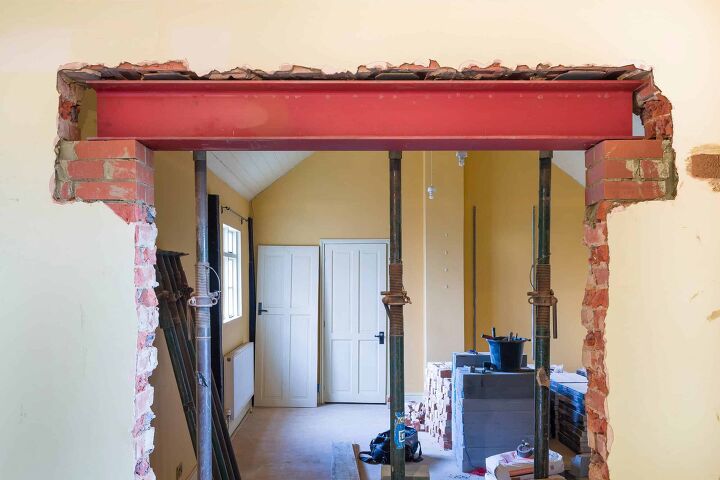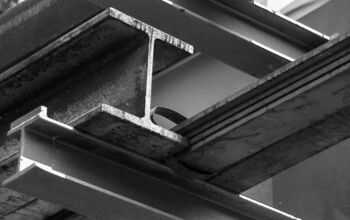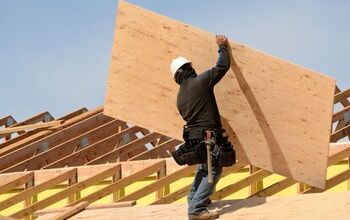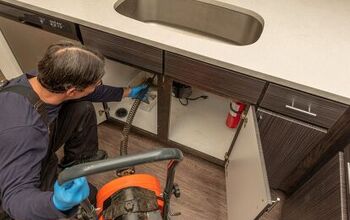How Much Does It Cost to Replace a Rotted Support Beam?

Support beams are the load-bearing planks that hold up your home. If you have noticed a rotted or damaged support beam, it is essential to get it fixed before it gives out. You may be wondering about the cost of this fix, and there are a lot of factors to consider.
The average cost to replace a rotted support beam is between $2,000 and $10,000. For more complicated jobs, you may find the cost can be as much as $25,000.
The cost depends on the size of the beam, the number of load-bearing walls affected, and the beam’s location. The material of the beam is also important, depending on if you decide to switch to steel or stick with wood. Finally, we will explain some finishing costs at the end, which you also need to keep in mind.
Do You Need Steel Beams Installation?
Get free, zero-commitment quotes from pro contractors near you.

Overview of the Costs
The process of replacing a rotted support beam involves a lot of steps. First, you need to have a structural engineer come inspect your home to understand how many load-bearing walls are affected. Next, your contractor will need to create temporary supports for all these pieces before removing the rotted beam.
Then, the contractor can remove the rotted beam and install the new beam. At this point, the temporary beams can all be removed. Finally, you or your contractor will need to finish the space, replacing any drywall and molding that had to be removed.
While all this in mind, you can see how the installation costs can add up. Material costs are only part of the equation. Below we cover the many different material costs, then installation as a whole.
Beam Material Cost
Just because you previously had a wooden beam doesn’t mean you need to replace it with one. As you have experienced, wood is liable to rot when exposed to moisture. It is also susceptible to termites and other insects and can burn in a fire.
You may find yourself considering different materials for your replacement beam, and each material has its own costs. While installation costs are definitely a larger part of the overall budget, the material costs are important as well. Below are cost estimations for two kinds of engineered wood, normal wood beams, and steel beams.
Material Cost of LVL Support Beams
The cheapest option is LVL, which is laminated veneer lumber. This material is made of pieces of plywood glued together with a hardwood veneer on the face. LVL is stronger than a normal wood beam. The veneer also provides an attractive finish for exposed beams.
Below are the different sizes available for LVL support beams (the depth x the width). The cost of support beams is then determined by the linear foot.
| Size | Cost per Linear Foot |
| 1.75” x 7.25”-11.25” | $3 – $5 |
| 1.75” x 14” or greater | $6 – $10 |
| 3.5” depth | $10 – $12 |
Material Cost of Wood Support Beams
Slightly more expensive than LVL, normal wood support beams tend to cost $5-$20 per linear foot. However, this figure varies by type of wood as well as the size. You can get wood beams in soft or hardwood. While softwoods are cheaper, hardwoods can bear more weight. Additionally, because they are denser, they are more resistant to fire.
| Type | Size | Cost per Linear Foot |
| Softwood | 6” x 6” | $5 – $30 |
| Softwood | 6” x 12” | $10 – $60 |
| Softwood | 12” depth | $20 – $90 |
| Hardwood | 4” depth | $10 – $20 |
| Hardwood | 6” x 6” | $10 – $20 |
| Hardwood | 6” x 12” | $20 – $30+ |
| Reclaimed Wood | 6” x 6” | $5 – $15 |
| Exotic Species of Hardwood | Varies | $30 – $90 |
Material Cost of Glulam Support Beams
The next material in terms of cost is glulam. Similar to LVL, this is an engineered support beam made gluing together multiple pieces of laminated wood. Hence the term, “glulam.” Typical sizes and their associated approximate costs are below.
| Size | Cost per Linear Foot |
| 3” depth (width available 6” – 12”) | $6 – $15 |
| 5” depth (width available 12” – 18”) | $15 – $35 |
| 6.75” depth (width is 12”) | $20 – $40 |
Material Cost of Steel Support Beams
Steel is, on average, the most costly of support beam materials. A good rule of thumb is that steel support beams typically cost $6-$20 per linear foot. There are two main types of steel beams, I-beams and H-beams. H-beams are more expensive since they are heavier, and therefore, able to bear more weight.
| Type | Size | Cost per Linear Foot |
| I-beam | 3” depth | $6 – $10 |
| I-beam | 4” depth | $8 – $15 |
| I-beam | 6” depth | $10 – $20 |
| H-beam | 4” width | $10 – $15 |
| H-beam | 6” width | $10 – $20 |
| H-beam | 12” width | $25 – $80 |
Advantages of Steel over Wood
While steel tends to be more expensive, you may find that the extra benefits are worth the extra cost.
- More durable
- Will not rot
- Not susceptible to termites and other insects
- Will not burn in case of fire (it could deform if exposed to intense fire for a long period)
One downside is that steel has the potential to rust if exposed to excess moisture. However, it can easily be coated or galvanized to prevent rusting. Additionally, steel beams or any of the engineered wood beams would need to be manufactured ahead of time. Standard wood is the only material that you can cut on-site. This can be an important benefit to shorten the lead-time on installation.
The Cost of Installing a Support Beam
The cost to install a wooden support beam will typically be $1,000 – $5,000. This price is similar to engineered wood beams and normal wood alike. However, steel beams can be much more expensive to install. A good rule is that steel beams will cost anywhere from $100-$400 per linear foot to install.
| Length | Installation Cost |
| 10’ | $1,000 – $4,000 |
| 20’ | $2,000 – $8,000 |
| 30’ | $3,000 – $12,000 |
This is because steel beams are extremely heavy. Installation may require special machinery. It will also require your contractor to take certain safety precautions since dropping a steel beam could crack your foundation.
There are a few other considerations that can affect the above costs. The cost to replace a rotted support beam can change based on the beam’s location. This is for two reasons: first, the structural location and second, the ease of access.
How the Beam’s Structural Location Affects Cost
To replace a rotted wooden support beam, you first need to add temporary supports around the area. These act to accept the weight that the rotted beam previously held. This way, when the rotted beam is removed, the load of your house is secured and will not collapse.
If the support beam that has rotted is integral to your home’s structure, it can require many additional temporary supports. The cost to replace the beam will increase because of all the extra time required to prepare the space. Of course, you cannot skip this step for load-bearing support beams.
How the Beam’s Ease of Access Affects Cost
The total cost to replace a rotted beam can increase if the beam is in a difficult location. If the location is relatively hard to access, it will take longer to deliver and install a new beam. Beams located in a basement, for example, are obviously easier to access than ones located in a crawl space.
Additionally, if your support beam is thirty feet long, your contractors may have trouble maneuvering it into place. In other words, the size of the beam may worsen problems caused by difficult access. Therefore, if you are paying by an hourly rate, the beam’s location could be a factor you need to consider.
Additional Costs Involved in a Support Beam Installation
Finally, there may be a few additional costs associated with your support beam installation. The most common examples are that the installation process requires tearing out drywall or rerouting utilities. In either case, the installation will take longer and require more labor.
If your rotted beam is in a finished space, you probably will have to tear out drywall to access it. This means that you need to factor in the cost of repairing the drywall, replacing molding, and repainting.
Support beams located in basements may be more easily accessible and therefore cheaper to repair. However, basement support beams are often located near HVAC ductwork, pipes for plumbing, or electrical wiring. If any of these utilities need to be rerouted, the installation cost will increase.
Do You Need Steel Beams Installation?
Get free, zero-commitment quotes from pro contractors near you.

Related Questions
Can I replace a support beam as a DIY project?
While it is definitely possible to complete this installation as a DIY project, you still need to consult an expert. You should have a structural engineer examine the space and give you instructions on where to locate the temporary supports. You may also need to employ electricians or plumbers to reroute utilities.Finally, you may still need to pay for the beam to be delivered and moved into place. Steel beams and particularly long wood beams will be too heavy to lift without machinery. Therefore, even as a DIY project, there will be a number of costs involved, aside from the material cost.
How do you fix a rotting support beam without replacing it?
There are ways to repair wood and provide it extra structural support. However, before doing so, it is important to get professional advice to make sure the beam does not need replacing. If the beam can be saved, you can create a bridge of support around the area with steel or wood. You should also consider sealing the wood to prevent more damage in the future.
Related Guides

Benjamin is a freelance writer and graphic designer. He is passionate about DIY projects and finding creative ways to upcycle things headed for the landfill. Based in Oakland, CA, Benjamin enjoys playing guitar and gardening.
More by Benjamin Panico


























